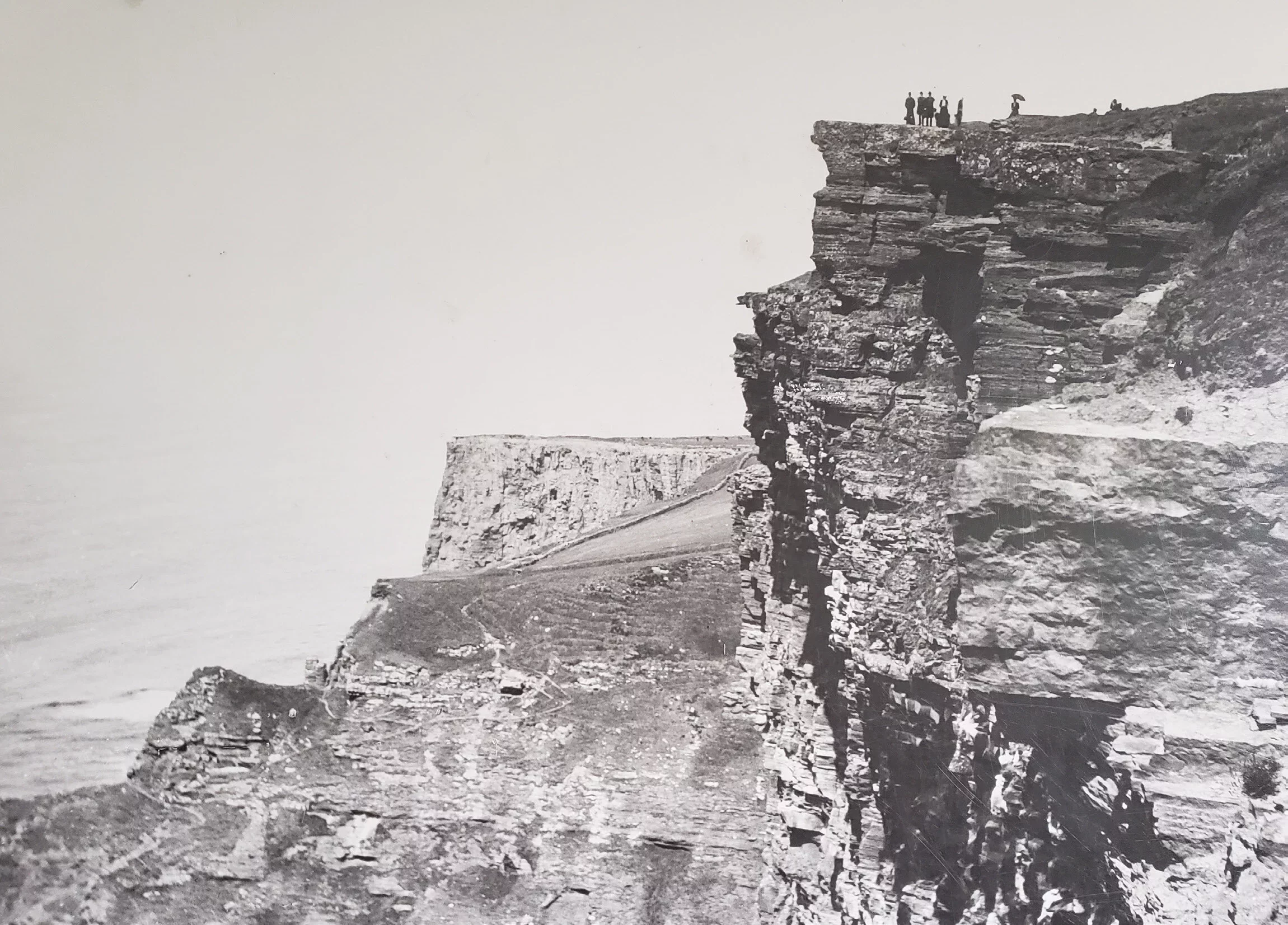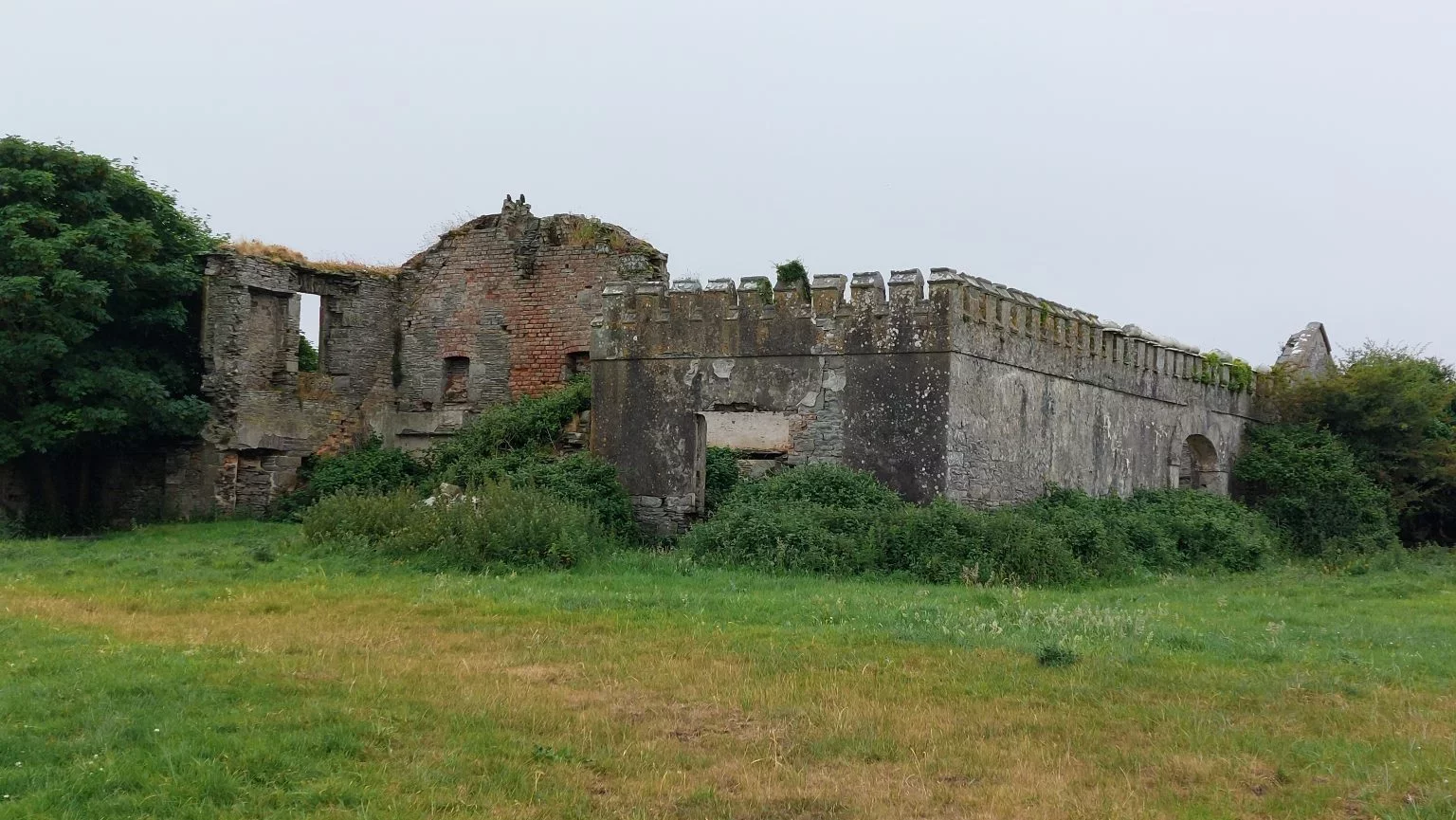Liscannor Stone -Fossils, Flagstones, and a Village Built on Rock

Walk anywhere in Liscannor and you will see it: blue-grey slabs of stone underfoot, in walls, in hearths, and in the pier polished smooth by centuries of tide. This is Liscannor Stone, the material that gave the village its reputation far beyond Ireland’s shores. More than a building stone, it is a canvas of deep time, a lifeline of trade, and a storyteller of human endurance.
Written in Stone: 300 Million Years Ago
The story of Liscannor Stone begins long before the village existed. Around 320 million years ago, the land that would become Clare lay near the equator. Rivers and deltas carried sand and silt into a shallow tropical sea, laying down layer upon layer of sediment. Over millennia, those sediments hardened into shale and sandstone — but they also captured the ripple marks of ancient water currents and the delicate imprints of plants and sea creatures.
When the slabs are split in quarry, these patterns appear like fossil hieroglyphs: fern fronds, shell marks, wave ripples, and sometimes even the trace of raindrops. Locals often called them “the writing of God” or “the footprints of saints,” while geologists marvelled at them as windows into prehistoric worlds. Each block of Liscannor Stone is thus not only a building material, but a page torn from the earth’s memory.
Quarrying the Hills
By the 18th and 19th centuries, quarrying had become one of Liscannor’s defining trades. Families worked together in hillside pits, prying flagstones from the earth with iron bars and chisels.
It was brutal, physical work. The quarries rang with the sound of hammers and wedges. Men split the heavy slabs, their backs bent under strain, while women and children hauled, stacked, and sorted. Donkeys dragged carts loaded with stone down rough tracks to the harbour. The risk of injury was constant — a misjudged swing, a falling slab, or a slip on wet ground could end a life or cripple a worker.
Yet there was pride, too. Quarrymen knew their stone was not just for local cottages; it was destined for great cities abroad. Each slab represented both hardship and achievement, each fossil ripple a reminder that they were handling something far older and grander than themselves.
The Harbour as Artery
The harbour at Liscannor, built in the 1820s, became the beating heart of this trade. At low tide, carts lined up along the quay, their wheels groaning under the weight of flagstones. Crews loaded ship after ship, the slabs stacked in holds bound for Britain and beyond.
In London, Liscannor Stone paved elegant districts like Kensington and Mayfair.
In Liverpool, it lined the docks where Irish emigrants boarded famine ships.
In Manchester, it floored the cotton mills of the Industrial Revolution.
In Paris, it was laid in courtyards and gardens.
In New York, it became part of the sidewalks of a growing metropolis.
It is said that Clare emigrants arriving in Liverpool or New York sometimes paused in astonishment — the same ripple-marked stone they had split back home now lay beneath their feet in a foreign land. The stone of their childhood hills had travelled with them, even as they had been forced to leave.
Pride and Bitterness
There is an old saying remembered in Clare:
“We cut the stone, they walked on it.”
It captures the ambivalence felt about the trade. On one hand, there was pride — that the name of a small Atlantic village had reached the grandest cities of the world, its stone admired for strength and beauty. On the other hand, there was bitterness. Quarrymen earned little, the work broke their bodies, and in the Famine years, while locals starved, ships still sailed away laden with stone.
Some felt the stone had been “taken” by England, an export that enriched others while the people of Liscannor endured poverty. Others saw it as a legacy: proof that even the most remote village could leave its mark on history.
Folklore in the Fossils
Beyond commerce, the stone held its own mythic dimension. Children traced the fern-like fossils and called them fairy marks. Some villagers said the ripple patterns were the frozen surface of the biblical Flood. Others believed they were the footprints of St. MacCreiche, linking the stone to Clare’s oldest saints.
Every slab carried a story. A hearthstone might be said to bring luck if its fossil pattern resembled a cross. A stepstone with deep ripples might be chosen for a church, seen as a sign of blessing. In this way, geology blended seamlessly with faith and folklore.
Decline and Survival
By the late 19th century, the demand for Liscannor Stone began to wane as cheaper building materials like concrete rose in use. Many of the quarries fell silent, their pits filling with rainwater and overgrown with gorse. Some families emigrated, others turned to fishing or farming.
Yet the stone never disappeared. In Liscannor itself, it remains everywhere: in the flagstone floors of kitchens, in doorsteps smoothed by generations of feet, in the harbour wall that still faces the tide. Its durability ensured it outlasted the industry that first made it famous.
Today, the Rock Shop near Liscannor keeps the story alive, displaying fossils and slabs, reminding visitors that what looks like ordinary paving is in fact extraordinary — the product of millions of years of geology and centuries of human labour.
Why it matters
Liscannor Stone is the essence of the village. It is the literal foundation of homes, walls, and streets. It is the reason the harbour bustled, the link that tied Clare to London and New York. It is a story of geology, of industry, of exploitation and pride, of folklore etched into fossil marks, and of a community whose name travelled the world on the backs of slabs.
To walk on Liscannor Stone — whether in the village itself, in the pavements of London, or in the streets of New York — is to walk on history: part ancient ocean bed, part human sweat, part story carved into stone.
Related Folklore
Other Heritage sites

Cliffs of Moher
Discover a place where deep time, nature, and myth converge. The Cliffs of Moher began their story 320 million years ago, a geological history visible in their fossil-rich layers of rock. Today, these ancient walls are alive as a protected haven for tens of thousands of seabirds, including puffins and falcons. This dramatic setting has inspired centuries of folklore, from the legend of the witch Mal at Hag’s Head to tales of lost Armada treasure, making the cliffs a landmark carved by both the ocean and the human imagination.

Seamount House — A Landmark of the Atlantic Gentry
Perched above Liscannor Bay, Seamount House is a striking early-19th-century Georgian/Regency residence built for the O’Brien family. With its grand sash windows and sweeping sea views, it embodied the confidence of Ireland’s “Big House” era — a world of elegance and privilege sustained by the labour of local tenants. Today, though softened by ivy and time, it remains a powerful reminder of both the grandeur and the contradictions of landlord life in Clare.
Ready to Explore Liscannor?
Questions? Need directions or recommendations? We’re here to help you make the most of your time in Liscannor.